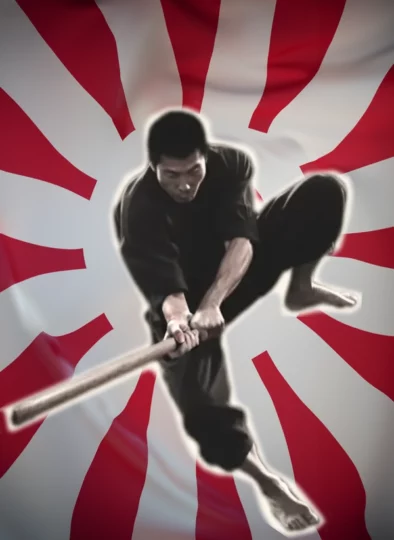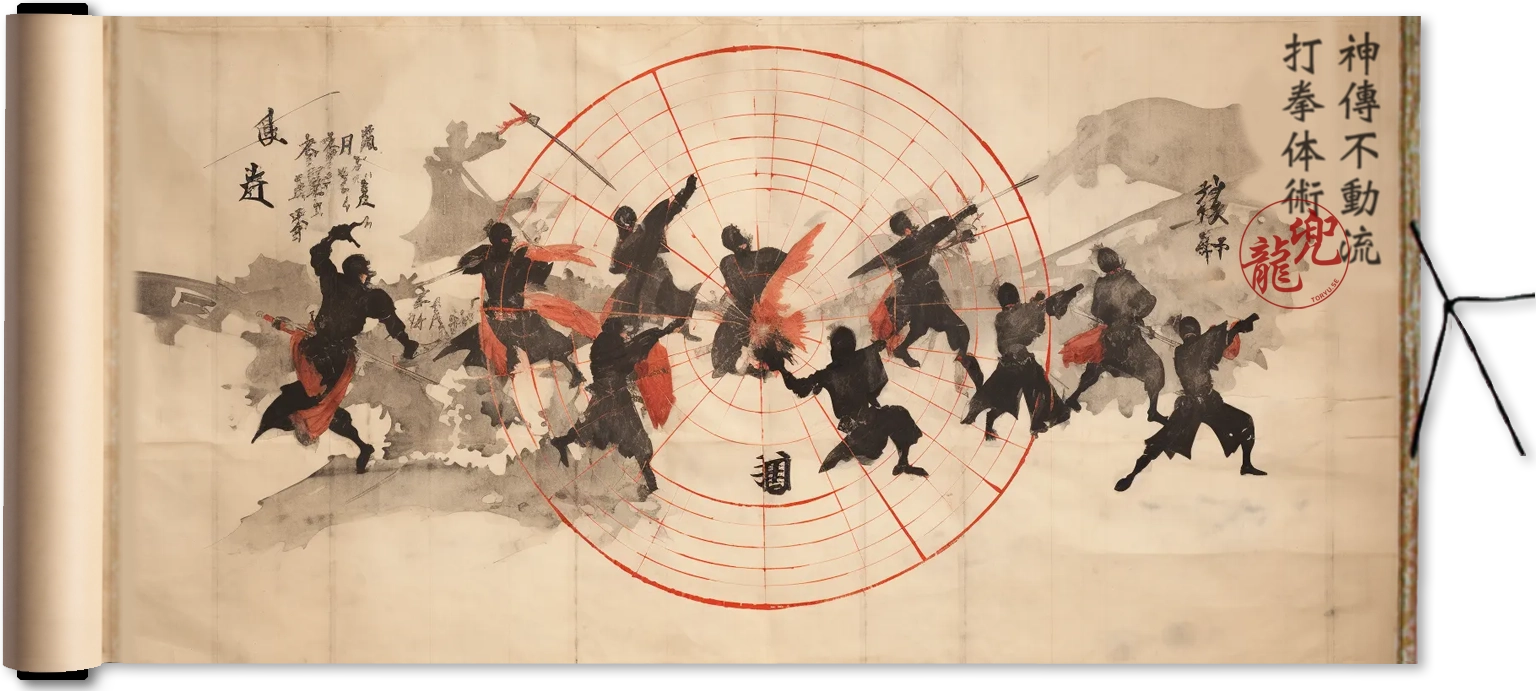神伝不動流打拳体術
SHINDENFUDŌ-RYŪ DAKEN TAIJUTSU
神伝不動流 Shindenfudō-ryū (the immovable transmissions by the gods) was founded by 源八郎為義 Minamoto Hachirō Tameyoshi in the Hogen Era (1156).

神 SHIN, JIN, kami : gods, mind, soul
伝 DEN, TEN, tsuta : summon, propagate, transmit
傳 DEN : summon, propagate, transmit
不 FU, BU : negative, non-, bad, ugly, clumsy
動 DŌ, ugo : move, motion, change, confusion, shift, shake
流 RYŪ, RU, nagare : current, a sink, flow, forfeit
打 DA, DASU : strike, hit, knock, pound, dozen
拳 KEN, GEN, kobushi : fist
体 TAI, TEI, karada : body, substance, object, reality
術 JUTSU, sube : art, technique, skill, means, trick, resources, magic
神伝不動流 Shindenfudō-ryū (the immovable transmissions by the gods) was founded by 源八郎為義 Minamoto Hachirō Tameyoshi in the Hogen Era (1156). The system has its origin from Kosshijutsu that came to Japan with Ikai and later transmitted to 出雲冠者義照 Izumo Kanja Yoshiteru in the Yeikyu Era (1113).
The school is specialized in 打拳体術 Dakentaijutsu (the fist striking methods) and 柔体術 Jutaijutsu (flexible body methods). The school uses several different types of Yari, Ono (War axes), O-tsuchi (war hammers) and Naginata. Hojojutsu (the art of tying a person with a rope) is used along side the Taijutsu, to help restrain the opponent. An important aspect of Shinden Fudo Ryu is that the techniques can be performed while wearing the Daisho. Another important point in this school’s waza is that the foe is brought to the ground so they cannot land safely. In the Jutaijutsu densho it is said that you will use Jujutsu to take the opponent down and then you will use Dakenjutsu.
As I understand it, the school originally included both Dakentaijutsu and Jūtaijutsu. At some point, it split into two separate lines:
- 神伝不動流打拳体術 – Shindenfudō-ryū Dakentaijutsu
- 神傳不動流柔体術 – Shindenfudō-ryū Jūtaijutsu
Later, the two lines were reunited, but Hatsumi Sensei was officially appointed Sōke only of the Dakentaijutsu line. However, he was certainly familiar with the Jūtaijutsu techniques as well, having learned them from a former teacher who had studied under Takamatsu Sensei.
Everything in nature has to compete to live, and this form of survival is taught in the form of the life of nature.
From Unarmed Fighting Techniques of the Samurai by Hatsumi Masaaki
For a list of all the techniques in Shindenfudō-ryū click here!

傳系 DENKEI
[kanji?]
[kanji?]
1. 出雲冠者義照
2. 源八幡七郎為成
3. 源八郎為義
4. 水原九郎義成
5. 無外坊真念
6. 大国善八郎義信
7. 畑三郎左助康
8. 小谷友八郎信近
9. 金子仁助由清
10. 田島源九郎成吉
11. 神門小冠者義兼
12. 木村宝山
13. 伊吹義原
14. 大塚伯耆
15. 大塚大九郎忠秀
16. 阿部無我
17. 甲賀太郎兵衛小角
18. 片山伯久安
19. 進藤運斎
20. 小田切藤兵衛義広
21. 飯田十兵衛為義
22. 森源六正秀
23. 豊田重兵衛光好
24. 戸田真竜軒正光
25. 高松寿嗣翊翁
26. 初見良昭
27. 長登敏郎
Hogenbo Tesshin
Sakabe Tendo
Izumo Kanja Yoshiteru (Yeikyu Era 1113)
Minamoto Hachiman Shichirō Tamenari (Genyei Era 1118)
Minamoto Hachirō Tameyoshi (Hogen Era 1156)
Mizuhara Kurō Yoshinari (Genkyu Era 1204)
Mugaibo Shinnen (Tempuku Era 1233)
Ōkuni Zenhachirō Yoshinobu (Bunyie Era 1264)
Hata Saburō Sasukeyasu ( )
Kotani Yuhachirō Nobuchika (Genko Era 1321)
Kaneko Jinsuke Yoshikiyo (Shohei Era 1346)
Tajima Genkurō Nariyoshi (Genchu Era 1384)
Kammon Kokanja Yoshikane (Shocho Era 1428)
Kimura Hozan (Kwansho Era 1460)
Ibuki Yoshihara (Bummei Era 1469)
Ōtsuka Hakushi (Yeisho Era 1504)
Ōtsuka Daikurō Tadahide (Taiyei Era 1522)
Abe Muga (Tensho Era 1573)
Kōga Tarōbei Kyokokaku (Tensho Era 1573)
Katayama Hisayasu (Bunroku Era 1592)
Shindō Unsai (Kwanyei Era 1624)
Odagiri Toyoe Yoshihiro (Kwanyei Era 1624)
Iida Jūbei Tameyoshi (Meiwa Era 1764)
Mori Genroku Masahide (Bunkwa Era 1804)
Toyota Jūbei Mitsuyoshi (Keio Era 1865)
Toda Shinryuken Masamitsu (B. 1824 – D. 1909)
Takamatsu Toshitsugu Uoh (B. 1887 – D. 1972)
Hatsumi Masaaki (B. 1931 – Present)
Nagatō Toshirō (B. 1947 – Present)
.
The dates of the early masters is when they where active. There is a 140 year gap between 1624 and 1764 in the list above. There is two persons active in 1624, so it might be a typo (I don’t know)?